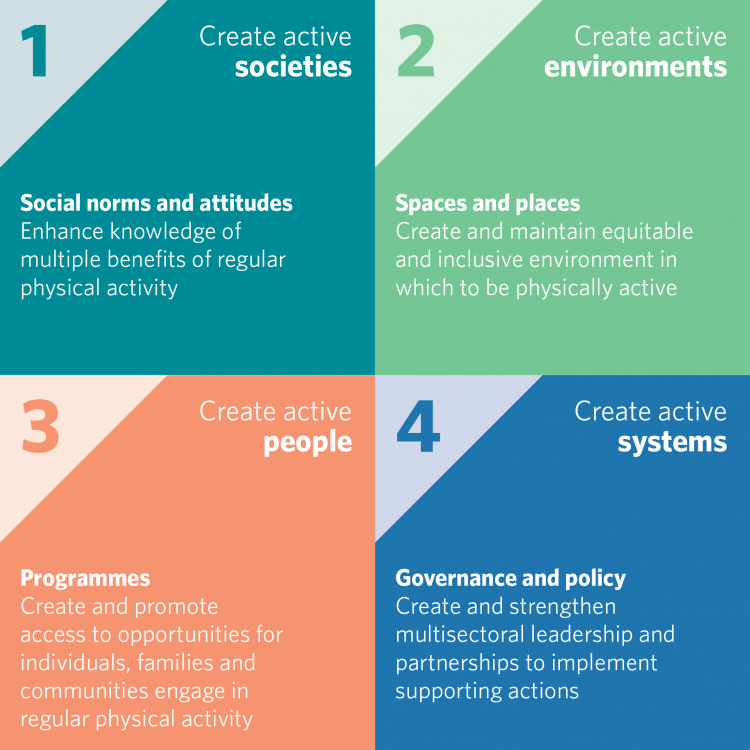Walking is estimated to provide health benefits of $2.60 per kilometre[1].
Many trips start and end with walking. This has been long acknowledged in health studies, where walking is considered the keystone to promote healthier lifestyles based on physical activities.
Reducing physical inactivity by walking is one of the World Health Organization’s priorities and considered one of the best investments to achieve health and sustainable development for all, with a goal to attain a 15% reduction of sedentary activities by 2030.[2]
Creating active environments that support walking is part of 'systems-based' approach to addressing the effects of inactivity.[3]

A systems-based approach (based on WHO Global Action Plan on Physical Activity)
In New Zealand, physical inactivity contributes to around 9% of all deaths.[4] By some measures, half of the population is insufficiently physically active[5] and nine out of ten New Zealand adolescents do not meet WHO recommended activity levels.[6]
The health benefits of walking include:
As a low income person who cannot drive, walking is a really important form of exercise for me. If I can trust my walking route I will use it a lot, to get places and just for exercise. |
Walking can also improve mental health and well-being, by having a positive impact on self-esteem, physical self-worth, stress, mood and mindset.[14] An Australian study found that those who walked for recreation for more than 8.6 minutes per day were 72% more likely to report better physical health and 33% more likely to report better mental health than those who walked less.[15]
When I walk to school, I like the fresh air and I get to chat to my friends on the way, and if I take my scooter it's fun. |
Active travel to school not only incorporates physical activity into students daily lives (with resulting health benefits) but also helps children concentrate at school – a Danish study found that children who bike or walk to school have greater concentration than those who are driven.[16] A meta-analysis of the research shows strong evidence that active travel to school is positively related to academic performance.[17]
[1] Waka Kotahi NZ Transport Agency. (2020). Monetised benefits and costs manual
[2] Appolloni, L., Corazza, M, & D’Alessandro, D. (2019). The Pleasure of Walking: An Innovative Methodology to Assess Appropriate Walkable Performance in Urban Areas to Support Transport Planning(external link). Sustainability 11(12)
[3] World Health Organisation. (2018). Global Action Plan on Physical Activity(external link)
[4] National Health Committee. (2002). New Zealand Evidence for Health Impacts of Transport (external link)
[5] Wellington Regional Strategy, Waikato Regional Council and Auckland Council. (2013). The Costs of Physical Inactivity: Toward a regional full cost accounting perspective(external link)
[6] Guthold, R. (2019). Global trends in insufficient physical activity among adolescents: a pooled analysis of 298 population-based surveys with 1·6 million participants. The Lancet Child & Adolescent Health(external link)
[7] Genter, J.A., Donovan, S. & Petrenas, B. (2008). Valuing the health benefits of active transport modes(external link), Waka Kotahi NZ Transport Agency Research Report 35. Accessed 6 April 2020.(external link)
[8] World Health Organization. Health Equity Assessment Toolkit (HEAT)(external link). Accessed 6 April 2020.(external link)
[9] C3 Collaborating for Health. (2012). The benefits of regular walking for health, well-being and the environment(external link) Accessed 20 January 2020.
[10] Creatore M.I., Glazier R.H., Moineddin R., et al. (2016). Association of Neighborhood Walkability with Change in Overweight, Obesity, and Diabetes(external link).
[11] Booth, G.L., Creatore, M.I., Luo, J., et al. (2019). Neighbourhood walkability and the incidence of diabetes: an inverse probability of treatment weighting analysis. J Epidemiology Community Health.73:287-294
[12] Frank, L.D., Andresen, M.A., & Schmid, T.L. (2004). Obesity relationships with community design, physical activity, and time spent in cars(external link).
American Journal of Preventive Medicine. 27(2):87-96
[13] Ikeda, Erika, et al. (2018). Built environment associates of active school travel in New Zealand children and youth: A systematic meta-analysis using individual participant data(external link). Journal of Transport and Health. 9:117-131 DOI.(external link)
[14] Living Streets. (2011). Making the Case for Investment in the Walking Environment (external link)
[15] Row, J., & Aspinall, P. (2011). The restorative benefits of walking in urban and rural settings in adults with good and poor mental health(external link). Health Place, 17(1)
[16] Science Nordic. (2012). Children who walk to school concentrate better(external link)
[17] Singh, A., et al. (2012). Physical activity and performance at school: a systematic review of the literature including a methodological quality assessment(external link) Arch Pediatr Adolesc Med. 166(1):49-55